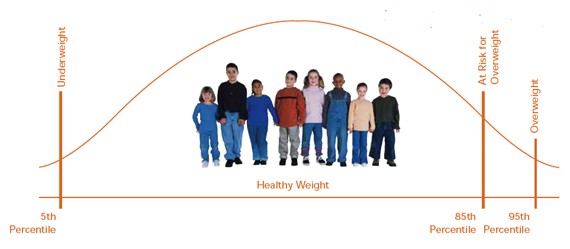In kids and teens, BMI percentile assesses underweight, overweight, and the risk for becoming overweight. As children mature, body fatness changes as they develop. There are differences between boys and girls. For these reasons, BMI percentile for children is gender and age specific. You will find that your pediatrician will use gender specific growth charts. These charts are used for children and teens 2 – 20 years of age. The chart will show the following for BMI:

BODY MASS INDEX
Your child has a BMI in the _____ th percentile.
• BMI less than the 5th percentile means your child is underweight
• BMI between the 5th and 84th percentile means your child is at a healthy weight
• BMI between the 85th to 95th percentile means the child is at risk for overweight
• BMI greater than 95th percentile means the child is overweight
What does it mean if my child has a BMI greater than the 95th percentile?
If your child has a BMI greater than the 95th percentile, your child:
• Has a BMI higher than 95% of all children when compared to the same age and gender.
• Is considered to be overweight.
• Will most likely be overweight as an adult if lifestyle changes are not addressed
and changed.
• Is at risk for high blood pressure, cholesterol, and diabetes.
Below are specific strategies that should be a part of your child’s lifestyle:
Activity: Take Action!
• Activity goal: 60 minutes per day… but even 10 minutes of activity is healthy!
• Encourage all family members to be active every day – have fun together!
• Go for family walks, hikes, bike rides.
• Dance to your favorite music.
• Take kids to playgrounds and recreation centers.
• Park farther away from stores or malls.
• Take the stairs.
• Limit TV watching, to 1-2 hours a day.
• Limit computer and video games.
Nutrition: Eat Healthy!
• Serve fruits or vegetables at every meal (1 serving = ½-1 cup, or 1 small piece of fruit).
• Eat family meals together.
• Eat breakfast every day.
• Limit sweetened fruit drinks, sodas, fast foods, and fried foods.
• Reduce 2nd helpings and portion sizes.
Offer healthy choices…
• Chicken, turkey, fish or beans
• Snacks – low-fat popcorn, low-fat pretzels, vegetables and dip, or yogurt
• Bake, broil, boil or steam foods
• Breakfast – high fiber cereal, non-fat milk, fruit